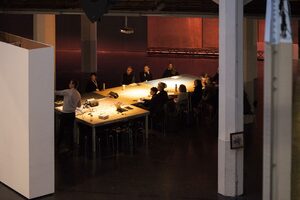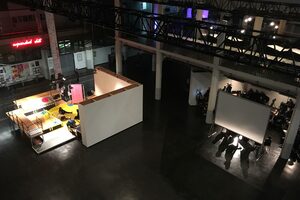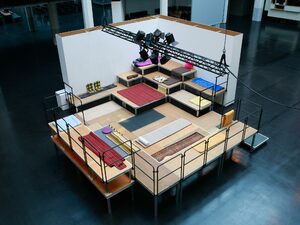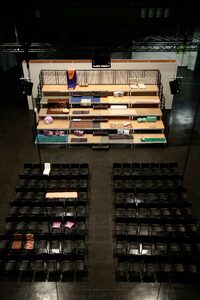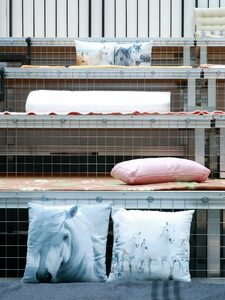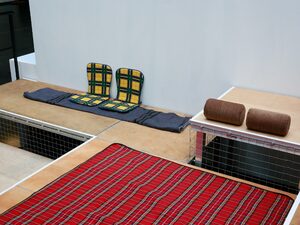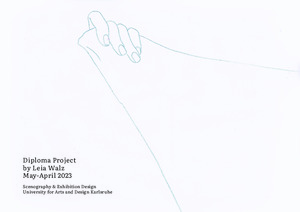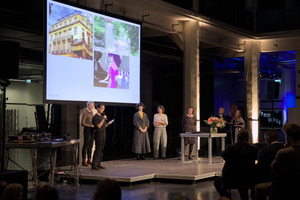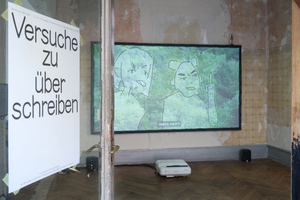Miki Feller
| Name | Miki Feller |
20 Inhalte
- Seite 1 von 2
Matters of Communication
- Titel
- Matters of Communication
- Titel (en)
- Matters of Communication
- Untertitel
- 15th annual meeting of the German Society for Design Theory and Research
- Untertitel des Projekts/Werks (en)
- 15th annual meeting of the German Society for Design Theory and Research
- Autor/in
- Beschreibung (de)
- Ob Raum, Bild, Text, Objekt oder System - Design ist immer auch Kommunikation. Vor dem Hintergrund der zunehmenden Radikalisierung, Segmentierung und Polemisierung gesellschaftlicher Diskurse scheint das Verhältnis von Design und Kommunikation heute brisanter denn je. Ständig entstehen neue Kommunikationsmedien, -kanäle, -räume und -systeme. Maschinen, Objekte, ja ganze Umgebungen werden zu eigenständigen Akteuren, die mit uns kommunizieren und auf verschiedenen medialen Ebenen interagieren. Wie können wir die Kontexte, die Möglichkeitsbedingungen und Wirkungszusammenhänge im Hinblick auf gestaltete Kommunikation ausloten? Welche Konzepte werden benötigt, um das Verhältnis von Design und Kommunikation aus heutiger Sicht zu konzeptualisieren?
Die DGTF-Konferenz "Matters of Communication" schafft einen Raum für die Diskussion darüber, wie Kommunikation heute gestaltet wird und wie Design heute kommuniziert wird. Welches sind die wegweisenden Ansätze und Methoden der Designforschung in Bezug auf Kommunikation durch und in zeitgenössischen Ausdrucksformen sowie kultureller und wirtschaftlicher Produktion? Wie reflektieren Forschungsprojekte "Matters of Communication", d.h. die Form und Materialität gestalteter Kommunikation, und ihre Rolle bei der Entstehung von Zuschreibungen und Interpretationskontexten? Welche Rolle spielt die Designforschung bei der Entwicklung von relevanten Fragestellungen und Lösungen? Wie erfolgt die Theoriebildung und Umsetzung in Lehre und Praxis?
- Ob Raum, Bild, Text, Objekt oder System - Design ist immer auch Kommunikation. Vor dem Hintergrund der zunehmenden Radikalisierung, Segmentierung und Polemisierung gesellschaftlicher Diskurse scheint das Verhältnis von Design und Kommunikation heute brisanter denn je. Ständig entstehen neue Kommunikationsmedien, -kanäle, -räume und -systeme. Maschinen, Objekte, ja ganze Umgebungen werden zu eigenständigen Akteuren, die mit uns kommunizieren und auf verschiedenen medialen Ebenen interagieren. Wie können wir die Kontexte, die Möglichkeitsbedingungen und Wirkungszusammenhänge im Hinblick auf gestaltete Kommunikation ausloten? Welche Konzepte werden benötigt, um das Verhältnis von Design und Kommunikation aus heutiger Sicht zu konzeptualisieren?
- Beschreibung (en)
- Whether space, image, text, object or system — design is always also communication. Against the backdrop of increasing radicalization, segmentation and polemization of social discourses, the relationship between design and communication seems more volatile today than ever. New communications media, channels, spaces and systems are constantly emerging. Machines, objects, even entire environments become independent actors that communicate with us and interact on various media levels. How can we sound out the contexts, the conditions that lead to possibility and the interdependencies of impact with regard to designed communication? What concepts are needed to conceptualize the relationship between design and communication from a present-day point of view?
The DGTF conference “Matters of Communication” creates a space for discussion about how communication is designed today and how design is communicated today. What are the pioneering approaches and methods of design research in relation to communication through and within contemporary forms of expression, as well as cultural and economic production? How do research projects reflect “Matters of Communication”, i.e. the form and materiality of designed communication, and their role in the emergence of attributions and interpretation contexts? What is the role that design research plays in the development of relevant questions and solutions? How is theory formation and translation into teaching and practice carried out?
- Whether space, image, text, object or system — design is always also communication. Against the backdrop of increasing radicalization, segmentation and polemization of social discourses, the relationship between design and communication seems more volatile today than ever. New communications media, channels, spaces and systems are constantly emerging. Machines, objects, even entire environments become independent actors that communicate with us and interact on various media levels. How can we sound out the contexts, the conditions that lead to possibility and the interdependencies of impact with regard to designed communication? What concepts are needed to conceptualize the relationship between design and communication from a present-day point of view?
- Typ des Projekts/Werks
- Schlagworte
- Datierung
- 16.11.2018 - 18.11.2018
- Mitwirkende
- Sprache
- Ort: Institution
- Ort
- Lichthöfe
- Stadt
- Land
- Beteiligte Institution(en)
- Internetlinks
- Bemerkungen
- Graphik-Design: Lena Haselmann and Catharina Grözinger, © DGTF
- Titel
- Matters of Communication
- Urheberrechtshinweis
- Vera Gärtner, Jana Hofmann, Calvin Kudufia
- Rechtsschutz/Lizenz
- Medienersteller/in
- Projektleiter/in
- Semester
- Lehrveranstaltung
- Importiert am
- 21.06.2023
- Übergeordnete Sets
- 1
Matters of Communication
- Titel
- Matters of Communication
- Titel (en)
- Matters of Communication
- Untertitel
- 15th annual meeting of the German Society for Design Theory and Research
- Untertitel des Projekts/Werks (en)
- 15th annual meeting of the German Society for Design Theory and Research
- Autor/in
- Beschreibung (de)
- Ob Raum, Bild, Text, Objekt oder System - Design ist immer auch Kommunikation. Vor dem Hintergrund der zunehmenden Radikalisierung, Segmentierung und Polemisierung gesellschaftlicher Diskurse scheint das Verhältnis von Design und Kommunikation heute brisanter denn je. Ständig entstehen neue Kommunikationsmedien, -kanäle, -räume und -systeme. Maschinen, Objekte, ja ganze Umgebungen werden zu eigenständigen Akteuren, die mit uns kommunizieren und auf verschiedenen medialen Ebenen interagieren. Wie können wir die Kontexte, die Möglichkeitsbedingungen und Wirkungszusammenhänge im Hinblick auf gestaltete Kommunikation ausloten? Welche Konzepte werden benötigt, um das Verhältnis von Design und Kommunikation aus heutiger Sicht zu konzeptualisieren?
Die DGTF-Konferenz "Matters of Communication" schafft einen Raum für die Diskussion darüber, wie Kommunikation heute gestaltet wird und wie Design heute kommuniziert wird. Welches sind die wegweisenden Ansätze und Methoden der Designforschung in Bezug auf Kommunikation durch und in zeitgenössischen Ausdrucksformen sowie kultureller und wirtschaftlicher Produktion? Wie reflektieren Forschungsprojekte "Matters of Communication", d.h. die Form und Materialität gestalteter Kommunikation, und ihre Rolle bei der Entstehung von Zuschreibungen und Interpretationskontexten? Welche Rolle spielt die Designforschung bei der Entwicklung von relevanten Fragestellungen und Lösungen? Wie erfolgt die Theoriebildung und Umsetzung in Lehre und Praxis?
- Ob Raum, Bild, Text, Objekt oder System - Design ist immer auch Kommunikation. Vor dem Hintergrund der zunehmenden Radikalisierung, Segmentierung und Polemisierung gesellschaftlicher Diskurse scheint das Verhältnis von Design und Kommunikation heute brisanter denn je. Ständig entstehen neue Kommunikationsmedien, -kanäle, -räume und -systeme. Maschinen, Objekte, ja ganze Umgebungen werden zu eigenständigen Akteuren, die mit uns kommunizieren und auf verschiedenen medialen Ebenen interagieren. Wie können wir die Kontexte, die Möglichkeitsbedingungen und Wirkungszusammenhänge im Hinblick auf gestaltete Kommunikation ausloten? Welche Konzepte werden benötigt, um das Verhältnis von Design und Kommunikation aus heutiger Sicht zu konzeptualisieren?
- Beschreibung (en)
- Whether space, image, text, object or system — design is always also communication. Against the backdrop of increasing radicalization, segmentation and polemization of social discourses, the relationship between design and communication seems more volatile today than ever. New communications media, channels, spaces and systems are constantly emerging. Machines, objects, even entire environments become independent actors that communicate with us and interact on various media levels. How can we sound out the contexts, the conditions that lead to possibility and the interdependencies of impact with regard to designed communication? What concepts are needed to conceptualize the relationship between design and communication from a present-day point of view?
The DGTF conference “Matters of Communication” creates a space for discussion about how communication is designed today and how design is communicated today. What are the pioneering approaches and methods of design research in relation to communication through and within contemporary forms of expression, as well as cultural and economic production? How do research projects reflect “Matters of Communication”, i.e. the form and materiality of designed communication, and their role in the emergence of attributions and interpretation contexts? What is the role that design research plays in the development of relevant questions and solutions? How is theory formation and translation into teaching and practice carried out?
- Whether space, image, text, object or system — design is always also communication. Against the backdrop of increasing radicalization, segmentation and polemization of social discourses, the relationship between design and communication seems more volatile today than ever. New communications media, channels, spaces and systems are constantly emerging. Machines, objects, even entire environments become independent actors that communicate with us and interact on various media levels. How can we sound out the contexts, the conditions that lead to possibility and the interdependencies of impact with regard to designed communication? What concepts are needed to conceptualize the relationship between design and communication from a present-day point of view?
- Typ des Projekts/Werks
- Schlagworte
- Datierung
- 16.11.2018 - 18.11.2018
- Mitwirkende
- Sprache
- Ort: Institution
- Ort
- Lichthöfe
- Stadt
- Land
- Beteiligte Institution(en)
- Internetlinks
- Bemerkungen
- Graphik-Design: Lena Haselmann and Catharina Grözinger, © DGTF
- Titel
- Matters of Communication
- Urheberrechtshinweis
- Vera Gärtner, Jana Hofmann, Calvin Kudufia
- Rechtsschutz/Lizenz
- Medienersteller/in
- Projektleiter/in
- Semester
- Lehrveranstaltung
- Importiert am
- 21.06.2023
- Übergeordnete Sets
- 1
Matters of Communication
- Titel
- Matters of Communication
- Titel (en)
- Matters of Communication
- Untertitel
- 15th annual meeting of the German Society for Design Theory and Research
- Untertitel des Projekts/Werks (en)
- 15th annual meeting of the German Society for Design Theory and Research
- Autor/in
- Beschreibung (de)
- Ob Raum, Bild, Text, Objekt oder System - Design ist immer auch Kommunikation. Vor dem Hintergrund der zunehmenden Radikalisierung, Segmentierung und Polemisierung gesellschaftlicher Diskurse scheint das Verhältnis von Design und Kommunikation heute brisanter denn je. Ständig entstehen neue Kommunikationsmedien, -kanäle, -räume und -systeme. Maschinen, Objekte, ja ganze Umgebungen werden zu eigenständigen Akteuren, die mit uns kommunizieren und auf verschiedenen medialen Ebenen interagieren. Wie können wir die Kontexte, die Möglichkeitsbedingungen und Wirkungszusammenhänge im Hinblick auf gestaltete Kommunikation ausloten? Welche Konzepte werden benötigt, um das Verhältnis von Design und Kommunikation aus heutiger Sicht zu konzeptualisieren?
Die DGTF-Konferenz "Matters of Communication" schafft einen Raum für die Diskussion darüber, wie Kommunikation heute gestaltet wird und wie Design heute kommuniziert wird. Welches sind die wegweisenden Ansätze und Methoden der Designforschung in Bezug auf Kommunikation durch und in zeitgenössischen Ausdrucksformen sowie kultureller und wirtschaftlicher Produktion? Wie reflektieren Forschungsprojekte "Matters of Communication", d.h. die Form und Materialität gestalteter Kommunikation, und ihre Rolle bei der Entstehung von Zuschreibungen und Interpretationskontexten? Welche Rolle spielt die Designforschung bei der Entwicklung von relevanten Fragestellungen und Lösungen? Wie erfolgt die Theoriebildung und Umsetzung in Lehre und Praxis?
- Ob Raum, Bild, Text, Objekt oder System - Design ist immer auch Kommunikation. Vor dem Hintergrund der zunehmenden Radikalisierung, Segmentierung und Polemisierung gesellschaftlicher Diskurse scheint das Verhältnis von Design und Kommunikation heute brisanter denn je. Ständig entstehen neue Kommunikationsmedien, -kanäle, -räume und -systeme. Maschinen, Objekte, ja ganze Umgebungen werden zu eigenständigen Akteuren, die mit uns kommunizieren und auf verschiedenen medialen Ebenen interagieren. Wie können wir die Kontexte, die Möglichkeitsbedingungen und Wirkungszusammenhänge im Hinblick auf gestaltete Kommunikation ausloten? Welche Konzepte werden benötigt, um das Verhältnis von Design und Kommunikation aus heutiger Sicht zu konzeptualisieren?
- Beschreibung (en)
- Whether space, image, text, object or system — design is always also communication. Against the backdrop of increasing radicalization, segmentation and polemization of social discourses, the relationship between design and communication seems more volatile today than ever. New communications media, channels, spaces and systems are constantly emerging. Machines, objects, even entire environments become independent actors that communicate with us and interact on various media levels. How can we sound out the contexts, the conditions that lead to possibility and the interdependencies of impact with regard to designed communication? What concepts are needed to conceptualize the relationship between design and communication from a present-day point of view?
The DGTF conference “Matters of Communication” creates a space for discussion about how communication is designed today and how design is communicated today. What are the pioneering approaches and methods of design research in relation to communication through and within contemporary forms of expression, as well as cultural and economic production? How do research projects reflect “Matters of Communication”, i.e. the form and materiality of designed communication, and their role in the emergence of attributions and interpretation contexts? What is the role that design research plays in the development of relevant questions and solutions? How is theory formation and translation into teaching and practice carried out?
- Whether space, image, text, object or system — design is always also communication. Against the backdrop of increasing radicalization, segmentation and polemization of social discourses, the relationship between design and communication seems more volatile today than ever. New communications media, channels, spaces and systems are constantly emerging. Machines, objects, even entire environments become independent actors that communicate with us and interact on various media levels. How can we sound out the contexts, the conditions that lead to possibility and the interdependencies of impact with regard to designed communication? What concepts are needed to conceptualize the relationship between design and communication from a present-day point of view?
- Typ des Projekts/Werks
- Schlagworte
- Datierung
- 16.11.2018 - 18.11.2018
- Mitwirkende
- Sprache
- Ort: Institution
- Ort
- Lichthöfe
- Stadt
- Land
- Beteiligte Institution(en)
- Internetlinks
- Bemerkungen
- Graphik-Design: Lena Haselmann and Catharina Grözinger, © DGTF
- Titel
- Matters of Communication
- Urheberrechtshinweis
- Vera Gärtner, Jana Hofmann, Calvin Kudufia
- Rechtsschutz/Lizenz
- Medienersteller/in
- Projektleiter/in
- Semester
- Lehrveranstaltung
- Importiert am
- 21.06.2023
- Übergeordnete Sets
- 1
Matters of Communication
- Titel
- Matters of Communication
- Titel (en)
- Matters of Communication
- Untertitel
- 15th annual meeting of the German Society for Design Theory and Research
- Untertitel des Projekts/Werks (en)
- 15th annual meeting of the German Society for Design Theory and Research
- Autor/in
- Beschreibung (de)
- Ob Raum, Bild, Text, Objekt oder System - Design ist immer auch Kommunikation. Vor dem Hintergrund der zunehmenden Radikalisierung, Segmentierung und Polemisierung gesellschaftlicher Diskurse scheint das Verhältnis von Design und Kommunikation heute brisanter denn je. Ständig entstehen neue Kommunikationsmedien, -kanäle, -räume und -systeme. Maschinen, Objekte, ja ganze Umgebungen werden zu eigenständigen Akteuren, die mit uns kommunizieren und auf verschiedenen medialen Ebenen interagieren. Wie können wir die Kontexte, die Möglichkeitsbedingungen und Wirkungszusammenhänge im Hinblick auf gestaltete Kommunikation ausloten? Welche Konzepte werden benötigt, um das Verhältnis von Design und Kommunikation aus heutiger Sicht zu konzeptualisieren?
Die DGTF-Konferenz "Matters of Communication" schafft einen Raum für die Diskussion darüber, wie Kommunikation heute gestaltet wird und wie Design heute kommuniziert wird. Welches sind die wegweisenden Ansätze und Methoden der Designforschung in Bezug auf Kommunikation durch und in zeitgenössischen Ausdrucksformen sowie kultureller und wirtschaftlicher Produktion? Wie reflektieren Forschungsprojekte "Matters of Communication", d.h. die Form und Materialität gestalteter Kommunikation, und ihre Rolle bei der Entstehung von Zuschreibungen und Interpretationskontexten? Welche Rolle spielt die Designforschung bei der Entwicklung von relevanten Fragestellungen und Lösungen? Wie erfolgt die Theoriebildung und Umsetzung in Lehre und Praxis?
- Ob Raum, Bild, Text, Objekt oder System - Design ist immer auch Kommunikation. Vor dem Hintergrund der zunehmenden Radikalisierung, Segmentierung und Polemisierung gesellschaftlicher Diskurse scheint das Verhältnis von Design und Kommunikation heute brisanter denn je. Ständig entstehen neue Kommunikationsmedien, -kanäle, -räume und -systeme. Maschinen, Objekte, ja ganze Umgebungen werden zu eigenständigen Akteuren, die mit uns kommunizieren und auf verschiedenen medialen Ebenen interagieren. Wie können wir die Kontexte, die Möglichkeitsbedingungen und Wirkungszusammenhänge im Hinblick auf gestaltete Kommunikation ausloten? Welche Konzepte werden benötigt, um das Verhältnis von Design und Kommunikation aus heutiger Sicht zu konzeptualisieren?
- Beschreibung (en)
- Whether space, image, text, object or system — design is always also communication. Against the backdrop of increasing radicalization, segmentation and polemization of social discourses, the relationship between design and communication seems more volatile today than ever. New communications media, channels, spaces and systems are constantly emerging. Machines, objects, even entire environments become independent actors that communicate with us and interact on various media levels. How can we sound out the contexts, the conditions that lead to possibility and the interdependencies of impact with regard to designed communication? What concepts are needed to conceptualize the relationship between design and communication from a present-day point of view?
The DGTF conference “Matters of Communication” creates a space for discussion about how communication is designed today and how design is communicated today. What are the pioneering approaches and methods of design research in relation to communication through and within contemporary forms of expression, as well as cultural and economic production? How do research projects reflect “Matters of Communication”, i.e. the form and materiality of designed communication, and their role in the emergence of attributions and interpretation contexts? What is the role that design research plays in the development of relevant questions and solutions? How is theory formation and translation into teaching and practice carried out?
- Whether space, image, text, object or system — design is always also communication. Against the backdrop of increasing radicalization, segmentation and polemization of social discourses, the relationship between design and communication seems more volatile today than ever. New communications media, channels, spaces and systems are constantly emerging. Machines, objects, even entire environments become independent actors that communicate with us and interact on various media levels. How can we sound out the contexts, the conditions that lead to possibility and the interdependencies of impact with regard to designed communication? What concepts are needed to conceptualize the relationship between design and communication from a present-day point of view?
- Typ des Projekts/Werks
- Schlagworte
- Datierung
- 16.11.2018 - 18.11.2018
- Mitwirkende
- Sprache
- Ort: Institution
- Ort
- Lichthöfe
- Stadt
- Land
- Beteiligte Institution(en)
- Internetlinks
- Bemerkungen
- Graphik-Design: Lena Haselmann and Catharina Grözinger, © DGTF
- Titel
- Matters of Communication
- Urheberrechtshinweis
- Vera Gärtner, Jana Hofmann, Calvin Kudufia
- Rechtsschutz/Lizenz
- Medienersteller/in
- Projektleiter/in
- Semester
- Lehrveranstaltung
- Importiert am
- 21.06.2023
- Übergeordnete Sets
- 1
Matters of Communication
- Titel
- Matters of Communication
- Titel (en)
- Matters of Communication
- Untertitel
- 15th annual meeting of the German Society for Design Theory and Research
- Untertitel des Projekts/Werks (en)
- 15th annual meeting of the German Society for Design Theory and Research
- Autor/in
- Beschreibung (de)
- Ob Raum, Bild, Text, Objekt oder System - Design ist immer auch Kommunikation. Vor dem Hintergrund der zunehmenden Radikalisierung, Segmentierung und Polemisierung gesellschaftlicher Diskurse scheint das Verhältnis von Design und Kommunikation heute brisanter denn je. Ständig entstehen neue Kommunikationsmedien, -kanäle, -räume und -systeme. Maschinen, Objekte, ja ganze Umgebungen werden zu eigenständigen Akteuren, die mit uns kommunizieren und auf verschiedenen medialen Ebenen interagieren. Wie können wir die Kontexte, die Möglichkeitsbedingungen und Wirkungszusammenhänge im Hinblick auf gestaltete Kommunikation ausloten? Welche Konzepte werden benötigt, um das Verhältnis von Design und Kommunikation aus heutiger Sicht zu konzeptualisieren?
Die DGTF-Konferenz "Matters of Communication" schafft einen Raum für die Diskussion darüber, wie Kommunikation heute gestaltet wird und wie Design heute kommuniziert wird. Welches sind die wegweisenden Ansätze und Methoden der Designforschung in Bezug auf Kommunikation durch und in zeitgenössischen Ausdrucksformen sowie kultureller und wirtschaftlicher Produktion? Wie reflektieren Forschungsprojekte "Matters of Communication", d.h. die Form und Materialität gestalteter Kommunikation, und ihre Rolle bei der Entstehung von Zuschreibungen und Interpretationskontexten? Welche Rolle spielt die Designforschung bei der Entwicklung von relevanten Fragestellungen und Lösungen? Wie erfolgt die Theoriebildung und Umsetzung in Lehre und Praxis?
- Ob Raum, Bild, Text, Objekt oder System - Design ist immer auch Kommunikation. Vor dem Hintergrund der zunehmenden Radikalisierung, Segmentierung und Polemisierung gesellschaftlicher Diskurse scheint das Verhältnis von Design und Kommunikation heute brisanter denn je. Ständig entstehen neue Kommunikationsmedien, -kanäle, -räume und -systeme. Maschinen, Objekte, ja ganze Umgebungen werden zu eigenständigen Akteuren, die mit uns kommunizieren und auf verschiedenen medialen Ebenen interagieren. Wie können wir die Kontexte, die Möglichkeitsbedingungen und Wirkungszusammenhänge im Hinblick auf gestaltete Kommunikation ausloten? Welche Konzepte werden benötigt, um das Verhältnis von Design und Kommunikation aus heutiger Sicht zu konzeptualisieren?
- Beschreibung (en)
- Whether space, image, text, object or system — design is always also communication. Against the backdrop of increasing radicalization, segmentation and polemization of social discourses, the relationship between design and communication seems more volatile today than ever. New communications media, channels, spaces and systems are constantly emerging. Machines, objects, even entire environments become independent actors that communicate with us and interact on various media levels. How can we sound out the contexts, the conditions that lead to possibility and the interdependencies of impact with regard to designed communication? What concepts are needed to conceptualize the relationship between design and communication from a present-day point of view?
The DGTF conference “Matters of Communication” creates a space for discussion about how communication is designed today and how design is communicated today. What are the pioneering approaches and methods of design research in relation to communication through and within contemporary forms of expression, as well as cultural and economic production? How do research projects reflect “Matters of Communication”, i.e. the form and materiality of designed communication, and their role in the emergence of attributions and interpretation contexts? What is the role that design research plays in the development of relevant questions and solutions? How is theory formation and translation into teaching and practice carried out?
- Whether space, image, text, object or system — design is always also communication. Against the backdrop of increasing radicalization, segmentation and polemization of social discourses, the relationship between design and communication seems more volatile today than ever. New communications media, channels, spaces and systems are constantly emerging. Machines, objects, even entire environments become independent actors that communicate with us and interact on various media levels. How can we sound out the contexts, the conditions that lead to possibility and the interdependencies of impact with regard to designed communication? What concepts are needed to conceptualize the relationship between design and communication from a present-day point of view?
- Typ des Projekts/Werks
- Schlagworte
- Datierung
- 16.11.2018 - 18.11.2018
- Mitwirkende
- Sprache
- Ort: Institution
- Ort
- Lichthöfe
- Stadt
- Land
- Beteiligte Institution(en)
- Internetlinks
- Bemerkungen
- Graphik-Design: Lena Haselmann and Catharina Grözinger, © DGTF
- Titel
- Matters of Communication
- Urheberrechtshinweis
- Vera Gärtner, Jana Hofmann, Calvin Kudufia
- Rechtsschutz/Lizenz
- Medienersteller/in
- Projektleiter/in
- Semester
- Lehrveranstaltung
- Importiert am
- 21.06.2023
- Übergeordnete Sets
- 1
Matters of Communication
- Titel
- Matters of Communication
- Titel (en)
- Matters of Communication
- Untertitel
- 15th annual meeting of the German Society for Design Theory and Research
- Untertitel des Projekts/Werks (en)
- 15th annual meeting of the German Society for Design Theory and Research
- Autor/in
- Beschreibung (de)
- Ob Raum, Bild, Text, Objekt oder System - Design ist immer auch Kommunikation. Vor dem Hintergrund der zunehmenden Radikalisierung, Segmentierung und Polemisierung gesellschaftlicher Diskurse scheint das Verhältnis von Design und Kommunikation heute brisanter denn je. Ständig entstehen neue Kommunikationsmedien, -kanäle, -räume und -systeme. Maschinen, Objekte, ja ganze Umgebungen werden zu eigenständigen Akteuren, die mit uns kommunizieren und auf verschiedenen medialen Ebenen interagieren. Wie können wir die Kontexte, die Möglichkeitsbedingungen und Wirkungszusammenhänge im Hinblick auf gestaltete Kommunikation ausloten? Welche Konzepte werden benötigt, um das Verhältnis von Design und Kommunikation aus heutiger Sicht zu konzeptualisieren?
Die DGTF-Konferenz "Matters of Communication" schafft einen Raum für die Diskussion darüber, wie Kommunikation heute gestaltet wird und wie Design heute kommuniziert wird. Welches sind die wegweisenden Ansätze und Methoden der Designforschung in Bezug auf Kommunikation durch und in zeitgenössischen Ausdrucksformen sowie kultureller und wirtschaftlicher Produktion? Wie reflektieren Forschungsprojekte "Matters of Communication", d.h. die Form und Materialität gestalteter Kommunikation, und ihre Rolle bei der Entstehung von Zuschreibungen und Interpretationskontexten? Welche Rolle spielt die Designforschung bei der Entwicklung von relevanten Fragestellungen und Lösungen? Wie erfolgt die Theoriebildung und Umsetzung in Lehre und Praxis?
- Ob Raum, Bild, Text, Objekt oder System - Design ist immer auch Kommunikation. Vor dem Hintergrund der zunehmenden Radikalisierung, Segmentierung und Polemisierung gesellschaftlicher Diskurse scheint das Verhältnis von Design und Kommunikation heute brisanter denn je. Ständig entstehen neue Kommunikationsmedien, -kanäle, -räume und -systeme. Maschinen, Objekte, ja ganze Umgebungen werden zu eigenständigen Akteuren, die mit uns kommunizieren und auf verschiedenen medialen Ebenen interagieren. Wie können wir die Kontexte, die Möglichkeitsbedingungen und Wirkungszusammenhänge im Hinblick auf gestaltete Kommunikation ausloten? Welche Konzepte werden benötigt, um das Verhältnis von Design und Kommunikation aus heutiger Sicht zu konzeptualisieren?
- Beschreibung (en)
- Whether space, image, text, object or system — design is always also communication. Against the backdrop of increasing radicalization, segmentation and polemization of social discourses, the relationship between design and communication seems more volatile today than ever. New communications media, channels, spaces and systems are constantly emerging. Machines, objects, even entire environments become independent actors that communicate with us and interact on various media levels. How can we sound out the contexts, the conditions that lead to possibility and the interdependencies of impact with regard to designed communication? What concepts are needed to conceptualize the relationship between design and communication from a present-day point of view?
The DGTF conference “Matters of Communication” creates a space for discussion about how communication is designed today and how design is communicated today. What are the pioneering approaches and methods of design research in relation to communication through and within contemporary forms of expression, as well as cultural and economic production? How do research projects reflect “Matters of Communication”, i.e. the form and materiality of designed communication, and their role in the emergence of attributions and interpretation contexts? What is the role that design research plays in the development of relevant questions and solutions? How is theory formation and translation into teaching and practice carried out?
- Whether space, image, text, object or system — design is always also communication. Against the backdrop of increasing radicalization, segmentation and polemization of social discourses, the relationship between design and communication seems more volatile today than ever. New communications media, channels, spaces and systems are constantly emerging. Machines, objects, even entire environments become independent actors that communicate with us and interact on various media levels. How can we sound out the contexts, the conditions that lead to possibility and the interdependencies of impact with regard to designed communication? What concepts are needed to conceptualize the relationship between design and communication from a present-day point of view?
- Typ des Projekts/Werks
- Schlagworte
- Datierung
- 16.11.2018 - 18.11.2018
- Mitwirkende
- Sprache
- Ort: Institution
- Ort
- Lichthöfe
- Stadt
- Land
- Beteiligte Institution(en)
- Internetlinks
- Bemerkungen
- Graphik-Design: Lena Haselmann and Catharina Grözinger, © DGTF
- Titel
- Matters of Communication
- Urheberrechtshinweis
- Vera Gärtner, Jana Hofmann, Calvin Kudufia
- Rechtsschutz/Lizenz
- Medienersteller/in
- Projektleiter/in
- Semester
- Lehrveranstaltung
- Importiert am
- 21.06.2023
- Übergeordnete Sets
- 1
Matters of Communication
- Titel
- Matters of Communication
- Titel (en)
- Matters of Communication
- Untertitel
- 15th annual meeting of the German Society for Design Theory and Research
- Untertitel des Projekts/Werks (en)
- 15th annual meeting of the German Society for Design Theory and Research
- Autor/in
- Beschreibung (de)
- Ob Raum, Bild, Text, Objekt oder System - Design ist immer auch Kommunikation. Vor dem Hintergrund der zunehmenden Radikalisierung, Segmentierung und Polemisierung gesellschaftlicher Diskurse scheint das Verhältnis von Design und Kommunikation heute brisanter denn je. Ständig entstehen neue Kommunikationsmedien, -kanäle, -räume und -systeme. Maschinen, Objekte, ja ganze Umgebungen werden zu eigenständigen Akteuren, die mit uns kommunizieren und auf verschiedenen medialen Ebenen interagieren. Wie können wir die Kontexte, die Möglichkeitsbedingungen und Wirkungszusammenhänge im Hinblick auf gestaltete Kommunikation ausloten? Welche Konzepte werden benötigt, um das Verhältnis von Design und Kommunikation aus heutiger Sicht zu konzeptualisieren?
Die DGTF-Konferenz "Matters of Communication" schafft einen Raum für die Diskussion darüber, wie Kommunikation heute gestaltet wird und wie Design heute kommuniziert wird. Welches sind die wegweisenden Ansätze und Methoden der Designforschung in Bezug auf Kommunikation durch und in zeitgenössischen Ausdrucksformen sowie kultureller und wirtschaftlicher Produktion? Wie reflektieren Forschungsprojekte "Matters of Communication", d.h. die Form und Materialität gestalteter Kommunikation, und ihre Rolle bei der Entstehung von Zuschreibungen und Interpretationskontexten? Welche Rolle spielt die Designforschung bei der Entwicklung von relevanten Fragestellungen und Lösungen? Wie erfolgt die Theoriebildung und Umsetzung in Lehre und Praxis?
- Ob Raum, Bild, Text, Objekt oder System - Design ist immer auch Kommunikation. Vor dem Hintergrund der zunehmenden Radikalisierung, Segmentierung und Polemisierung gesellschaftlicher Diskurse scheint das Verhältnis von Design und Kommunikation heute brisanter denn je. Ständig entstehen neue Kommunikationsmedien, -kanäle, -räume und -systeme. Maschinen, Objekte, ja ganze Umgebungen werden zu eigenständigen Akteuren, die mit uns kommunizieren und auf verschiedenen medialen Ebenen interagieren. Wie können wir die Kontexte, die Möglichkeitsbedingungen und Wirkungszusammenhänge im Hinblick auf gestaltete Kommunikation ausloten? Welche Konzepte werden benötigt, um das Verhältnis von Design und Kommunikation aus heutiger Sicht zu konzeptualisieren?
- Beschreibung (en)
- Whether space, image, text, object or system — design is always also communication. Against the backdrop of increasing radicalization, segmentation and polemization of social discourses, the relationship between design and communication seems more volatile today than ever. New communications media, channels, spaces and systems are constantly emerging. Machines, objects, even entire environments become independent actors that communicate with us and interact on various media levels. How can we sound out the contexts, the conditions that lead to possibility and the interdependencies of impact with regard to designed communication? What concepts are needed to conceptualize the relationship between design and communication from a present-day point of view?
The DGTF conference “Matters of Communication” creates a space for discussion about how communication is designed today and how design is communicated today. What are the pioneering approaches and methods of design research in relation to communication through and within contemporary forms of expression, as well as cultural and economic production? How do research projects reflect “Matters of Communication”, i.e. the form and materiality of designed communication, and their role in the emergence of attributions and interpretation contexts? What is the role that design research plays in the development of relevant questions and solutions? How is theory formation and translation into teaching and practice carried out?
- Whether space, image, text, object or system — design is always also communication. Against the backdrop of increasing radicalization, segmentation and polemization of social discourses, the relationship between design and communication seems more volatile today than ever. New communications media, channels, spaces and systems are constantly emerging. Machines, objects, even entire environments become independent actors that communicate with us and interact on various media levels. How can we sound out the contexts, the conditions that lead to possibility and the interdependencies of impact with regard to designed communication? What concepts are needed to conceptualize the relationship between design and communication from a present-day point of view?
- Typ des Projekts/Werks
- Schlagworte
- Datierung
- 16.11.2018 - 18.11.2018
- Mitwirkende
- Sprache
- Ort: Institution
- Ort
- Lichthöfe
- Stadt
- Land
- Beteiligte Institution(en)
- Internetlinks
- Bemerkungen
- Graphik-Design: Lena Haselmann and Catharina Grözinger, © DGTF
- Titel
- Matters of Communication
- Urheberrechtshinweis
- Vera Gärtner, Jana Hofmann, Calvin Kudufia
- Rechtsschutz/Lizenz
- Medienersteller/in
- Projektleiter/in
- Semester
- Lehrveranstaltung
- Importiert am
- 21.06.2023
- Übergeordnete Sets
- 1
Matters of Communication
- Titel
- Matters of Communication
- Titel (en)
- Matters of Communication
- Untertitel
- 15th annual meeting of the German Society for Design Theory and Research
- Untertitel des Projekts/Werks (en)
- 15th annual meeting of the German Society for Design Theory and Research
- Autor/in
- Beschreibung (de)
- Ob Raum, Bild, Text, Objekt oder System - Design ist immer auch Kommunikation. Vor dem Hintergrund der zunehmenden Radikalisierung, Segmentierung und Polemisierung gesellschaftlicher Diskurse scheint das Verhältnis von Design und Kommunikation heute brisanter denn je. Ständig entstehen neue Kommunikationsmedien, -kanäle, -räume und -systeme. Maschinen, Objekte, ja ganze Umgebungen werden zu eigenständigen Akteuren, die mit uns kommunizieren und auf verschiedenen medialen Ebenen interagieren. Wie können wir die Kontexte, die Möglichkeitsbedingungen und Wirkungszusammenhänge im Hinblick auf gestaltete Kommunikation ausloten? Welche Konzepte werden benötigt, um das Verhältnis von Design und Kommunikation aus heutiger Sicht zu konzeptualisieren?
Die DGTF-Konferenz "Matters of Communication" schafft einen Raum für die Diskussion darüber, wie Kommunikation heute gestaltet wird und wie Design heute kommuniziert wird. Welches sind die wegweisenden Ansätze und Methoden der Designforschung in Bezug auf Kommunikation durch und in zeitgenössischen Ausdrucksformen sowie kultureller und wirtschaftlicher Produktion? Wie reflektieren Forschungsprojekte "Matters of Communication", d.h. die Form und Materialität gestalteter Kommunikation, und ihre Rolle bei der Entstehung von Zuschreibungen und Interpretationskontexten? Welche Rolle spielt die Designforschung bei der Entwicklung von relevanten Fragestellungen und Lösungen? Wie erfolgt die Theoriebildung und Umsetzung in Lehre und Praxis?
- Ob Raum, Bild, Text, Objekt oder System - Design ist immer auch Kommunikation. Vor dem Hintergrund der zunehmenden Radikalisierung, Segmentierung und Polemisierung gesellschaftlicher Diskurse scheint das Verhältnis von Design und Kommunikation heute brisanter denn je. Ständig entstehen neue Kommunikationsmedien, -kanäle, -räume und -systeme. Maschinen, Objekte, ja ganze Umgebungen werden zu eigenständigen Akteuren, die mit uns kommunizieren und auf verschiedenen medialen Ebenen interagieren. Wie können wir die Kontexte, die Möglichkeitsbedingungen und Wirkungszusammenhänge im Hinblick auf gestaltete Kommunikation ausloten? Welche Konzepte werden benötigt, um das Verhältnis von Design und Kommunikation aus heutiger Sicht zu konzeptualisieren?
- Beschreibung (en)
- Whether space, image, text, object or system — design is always also communication. Against the backdrop of increasing radicalization, segmentation and polemization of social discourses, the relationship between design and communication seems more volatile today than ever. New communications media, channels, spaces and systems are constantly emerging. Machines, objects, even entire environments become independent actors that communicate with us and interact on various media levels. How can we sound out the contexts, the conditions that lead to possibility and the interdependencies of impact with regard to designed communication? What concepts are needed to conceptualize the relationship between design and communication from a present-day point of view?
The DGTF conference “Matters of Communication” creates a space for discussion about how communication is designed today and how design is communicated today. What are the pioneering approaches and methods of design research in relation to communication through and within contemporary forms of expression, as well as cultural and economic production? How do research projects reflect “Matters of Communication”, i.e. the form and materiality of designed communication, and their role in the emergence of attributions and interpretation contexts? What is the role that design research plays in the development of relevant questions and solutions? How is theory formation and translation into teaching and practice carried out?
- Whether space, image, text, object or system — design is always also communication. Against the backdrop of increasing radicalization, segmentation and polemization of social discourses, the relationship between design and communication seems more volatile today than ever. New communications media, channels, spaces and systems are constantly emerging. Machines, objects, even entire environments become independent actors that communicate with us and interact on various media levels. How can we sound out the contexts, the conditions that lead to possibility and the interdependencies of impact with regard to designed communication? What concepts are needed to conceptualize the relationship between design and communication from a present-day point of view?
- Typ des Projekts/Werks
- Schlagworte
- Datierung
- 16.11.2018 - 18.11.2018
- Mitwirkende
- Sprache
- Ort: Institution
- Ort
- Lichthöfe
- Stadt
- Land
- Beteiligte Institution(en)
- Internetlinks
- Bemerkungen
- Graphik-Design: Lena Haselmann and Catharina Grözinger, © DGTF
- Titel
- Matters of Communication
- Urheberrechtshinweis
- Vera Gärtner, Jana Hofmann, Calvin Kudufia
- Rechtsschutz/Lizenz
- Medienersteller/in
- Projektleiter/in
- Semester
- Lehrveranstaltung
- Importiert am
- 21.06.2023
- Übergeordnete Sets
- 1
Diploma project documentation 01
- Titel
- Diploma project documentation 01
- Titel (en)
- an invitation to an exhibition in a laundry
- Autor/in
- Beschreibung (de)
- "eine einladung zu einer ausstellung in einer waschküche" fand in einer Waschküche und einem Hinterhof in Karlsruhe
statt, einem Raum, der bisher nur für private Zwecke genutzt wurde. Das 18-tägige Programm erzählt von der alltäglichen und manuellen Arbeit von Wäscher*innen und der Stigmatisierung, der sie ausgesetzt sind. Indes wird das Waschen der Wäsche ein Referenzraum für die Auseinandersetzung mit den Überschneidungen von Reproduktiver Arbeit und Lohnarbeit.
Das Programm basiert auf einer Recherche, die die Strukturen dieser Stadt, ihre versteckten und ungesehenen eschichten sowie die Verflechtungen von sozialen Rollen und Räumen untersucht. Material aus verschiedenen Archiven und Gesprächen wird in drei Faltblättern gebündelt: „erinnern“, „arbeiten“ und „zusammenkommen“. Die Ausstellung im Hinterhof und in der Waschküche ist verknüpft mit der Recherche und entstand sukzessive durch persönlichen und intimen Austausch mit Künstler*innen und Freund*innen, die an der Staatlichen Hochschule für Gestaltung Karlsruhe studieren und studiert haben. Sie setzen sich zu bestimmten Aspekten der Recherche und der Metapher des Waschens in Relation und lassen dadurch weitere Überschneidungen und Verweise zu.
- "eine einladung zu einer ausstellung in einer waschküche" fand in einer Waschküche und einem Hinterhof in Karlsruhe
- Beschreibung (en)
- The project took place in a laundry room and backyard in Karlsruhe, a space that has only been used for private purposes. The programme that lasted 18 days tells of common and manual work of washerwomen* and the stigma
they are exposed to. Doing the laundry becomes a reference space to engage with the intersection of care work and wage labour.
The programme is based on a research that draws attention to this very city‘s structure, its hidden and unseen stories as well as the crossing of social roles and spaces. Material from various archives and conversations is bundled in three leaflets: “remembering”, “working” and “coming together”. The research was accompanied by an exhibition. It gathered the voices of close friends and artists who study or have studied at the University of Arts and Design Karlsruhe. They were invited to respond to the research and contribute works that relate to specific aspects and the metaphor of washing. The exhibition successively resulted from these personal and intimate conversations and thereby allowed
further ramifications, intersections and references.
- The project took place in a laundry room and backyard in Karlsruhe, a space that has only been used for private purposes. The programme that lasted 18 days tells of common and manual work of washerwomen* and the stigma
- Typ des Projekts/Werks
- Schlagworte
- Datierung
- 26.04.2023 - 14.05.2023
- Mitwirkende
- Dank an
- Sprache
- Ort
- Privater Hinterhof und Waschküche in Karlsruhe
- Stadt
- Land
- Titel
- Diploma project documentation 01
- Urheberrechtshinweis
- Leia Walz
- Rechtsschutz/Lizenz
- Freigabe Nutzung HfG
- Importiert am
- 13.09.2023
- Übergeordnete Sets
- 1
Semestereröffnung WiSe 2023
- Titel
- Semestereröffnung WiSe 2023
- Titel (en)
- Semestereröffnung WiSe 2023
- Autor/in
- Beschreibung (de)
- Die Hochschule heißt die Erstsemester, Studierenden und Angehörigen der HfG Karlsruhe sowie Gäste, Freund:innen und Fördernde zum Beginn des Wintersemesters 2023/2024 in einer festlichen Semestereröffnung willkommen, die in diesem Jahr am Montag, 16. Oktober 2023 im Lichthof stattfindet.
Programm:
ab 17:30 Bar und DJ-Set Finn Baygan
18:00-18:10 Eröffnung Prof. Constanze Fischbeck
18:10-18:15 Grußwort Alistair Hudson
18:15-18:20 Grußwort Prof. Dr. Rupert Vogel
18:25-18:35 Verabschiedung Mitarbeitende und Lehrende und Begrüßung der neuen Lehrenden durch Prof. Dr. Matthias Bruhn
18:40-18:50 Künstlerischer Beitrag von Finn Baygan
18:50-19:10 Diplomübergaben durch die Fachgruppen
19:10-19:20 Preisübergabe durch Bürgermeister Dr. Albert Käuflein mit Jana Renger & Guillermo Wilkins
19:20-19:25 AStA Beitrag
19:25-19:30 Danksagung durch Prof. Dr. Matthias Bruhn
19:30-20:30 Bar und DJ-Set Finn Baygan
20:30 Im Forum: Performance aaahhhnnndddiii
- Die Hochschule heißt die Erstsemester, Studierenden und Angehörigen der HfG Karlsruhe sowie Gäste, Freund:innen und Fördernde zum Beginn des Wintersemesters 2023/2024 in einer festlichen Semestereröffnung willkommen, die in diesem Jahr am Montag, 16. Oktober 2023 im Lichthof stattfindet.
- Beschreibung (en)
- The university welcomes the freshmen, students and members of the HfG Karlsruhe as well as guests, friends and supporters at the beginning of the winter semester 2023/2024 in a festive semester opening, which will take place this year on Monday, October 16, 2023 in the Lichthof.
Program:
from 17:30 Bar and DJ set Finn Baygan
18:00-18:10 Opening Prof. Constanze Fischbeck
18:10-18:15 Greeting Alistair Hudson
18:15-18:20 Greeting Prof. Dr. Rupert Vogel
18:25-18:35 Farewell to staff and lecturers and welcome to the new lecturers by Prof. Dr. Matthias Bruhn
18:40-18:50 Artistic contribution by Finn Baygan
18:50-19:10 Presentation of diplomas by the departments
19:10-19:20 Award ceremony by mayor Dr. Albert Käuflein with Jana Renger & Guillermo Wilkins
19:20-19:25 AStA Contribution
19:25-19:30 Acknowledgement by Prof. Dr. Matthias Bruhn
19:30-20:30 Bar and DJ-Set Finn Baygan
20:30 In the Forum: Performance aaahhhnnndddiii
- The university welcomes the freshmen, students and members of the HfG Karlsruhe as well as guests, friends and supporters at the beginning of the winter semester 2023/2024 in a festive semester opening, which will take place this year on Monday, October 16, 2023 in the Lichthof.
- Typ des Projekts/Werks
- Schlagworte
- Datierung
- 16.10.2023
- Mitwirkende
- Ort: Institution
- Ort
- Lichthof
- Stadt
- Land
- Beteiligte Institution(en)
- Internetlinks
- Titel
- Semestereröffnung WiSe 2023
- Titel (en)
- Semester Opening WS 2023
- Urheberrechtshinweis
- © HfG, photo: Jihye Jang
- Rechtsschutz/Lizenz
- Freigabe Nutzung HfG
- Medienersteller/in
- Beziehung/Funktion
- Abgebildete Personen
- Semester
- Importiert am
- 23.10.2023
- Übergeordnete Sets
- 1
Semestereröffnung WiSe 2023
- Titel
- Semestereröffnung WiSe 2023
- Titel (en)
- Semestereröffnung WiSe 2023
- Autor/in
- Beschreibung (de)
- Die Hochschule heißt die Erstsemester, Studierenden und Angehörigen der HfG Karlsruhe sowie Gäste, Freund:innen und Fördernde zum Beginn des Wintersemesters 2023/2024 in einer festlichen Semestereröffnung willkommen, die in diesem Jahr am Montag, 16. Oktober 2023 im Lichthof stattfindet.
Programm:
ab 17:30 Bar und DJ-Set Finn Baygan
18:00-18:10 Eröffnung Prof. Constanze Fischbeck
18:10-18:15 Grußwort Alistair Hudson
18:15-18:20 Grußwort Prof. Dr. Rupert Vogel
18:25-18:35 Verabschiedung Mitarbeitende und Lehrende und Begrüßung der neuen Lehrenden durch Prof. Dr. Matthias Bruhn
18:40-18:50 Künstlerischer Beitrag von Finn Baygan
18:50-19:10 Diplomübergaben durch die Fachgruppen
19:10-19:20 Preisübergabe durch Bürgermeister Dr. Albert Käuflein mit Jana Renger & Guillermo Wilkins
19:20-19:25 AStA Beitrag
19:25-19:30 Danksagung durch Prof. Dr. Matthias Bruhn
19:30-20:30 Bar und DJ-Set Finn Baygan
20:30 Im Forum: Performance aaahhhnnndddiii
- Die Hochschule heißt die Erstsemester, Studierenden und Angehörigen der HfG Karlsruhe sowie Gäste, Freund:innen und Fördernde zum Beginn des Wintersemesters 2023/2024 in einer festlichen Semestereröffnung willkommen, die in diesem Jahr am Montag, 16. Oktober 2023 im Lichthof stattfindet.
- Beschreibung (en)
- The university welcomes the freshmen, students and members of the HfG Karlsruhe as well as guests, friends and supporters at the beginning of the winter semester 2023/2024 in a festive semester opening, which will take place this year on Monday, October 16, 2023 in the Lichthof.
Program:
from 17:30 Bar and DJ set Finn Baygan
18:00-18:10 Opening Prof. Constanze Fischbeck
18:10-18:15 Greeting Alistair Hudson
18:15-18:20 Greeting Prof. Dr. Rupert Vogel
18:25-18:35 Farewell to staff and lecturers and welcome to the new lecturers by Prof. Dr. Matthias Bruhn
18:40-18:50 Artistic contribution by Finn Baygan
18:50-19:10 Presentation of diplomas by the departments
19:10-19:20 Award ceremony by mayor Dr. Albert Käuflein with Jana Renger & Guillermo Wilkins
19:20-19:25 AStA Contribution
19:25-19:30 Acknowledgement by Prof. Dr. Matthias Bruhn
19:30-20:30 Bar and DJ-Set Finn Baygan
20:30 In the Forum: Performance aaahhhnnndddiii
- The university welcomes the freshmen, students and members of the HfG Karlsruhe as well as guests, friends and supporters at the beginning of the winter semester 2023/2024 in a festive semester opening, which will take place this year on Monday, October 16, 2023 in the Lichthof.
- Typ des Projekts/Werks
- Schlagworte
- Datierung
- 16.10.2023
- Mitwirkende
- Ort: Institution
- Ort
- Lichthof
- Stadt
- Land
- Beteiligte Institution(en)
- Internetlinks
- Titel
- Semestereröffnung WiSe 2023
- Titel (en)
- Semester Opening WS 2023
- Urheberrechtshinweis
- © HfG, photo: Jihye Jang
- Rechtsschutz/Lizenz
- Freigabe Nutzung HfG
- Medienersteller/in
- Beziehung/Funktion
- Abgebildete Personen
- Semester
- Importiert am
- 23.10.2023
- Übergeordnete Sets
- 1
Versuche zu überschreiben
- Titel
- Versuche zu überschreiben
- Titel (en)
- Attempts to rewrite
- Untertitel des Projekts/Werks (en)
- Exhibition with three video works: On the way to the station, Prologue: In the zoo, Germania Girl - Concert in the castle!
- Autor/in
- Beschreibung (de)
- Obszön, nerdy und aus Japan: Anime im Fernsehen zu schauen galt in vielen Haushalten in Deutschland als verrufen. Diese Rezeption von Anime entspricht zugleich den exotisierenden Stereotypen, die der (vorgeblich gesittete) Westen auf Japan projiziert. In ihrer Diplomarbeit nutzt Miki Feller Anime als Medium, um über anti-asiatischen Rassismus zu sprechen. Entstanden sind drei Videoarbeiten, die sie in ihrer Ausstellung „Versuche zu überschreiben“ gezeigt hat. Jedes Video erzählt eine eigene Geschichte, die in Karlsruhe spielt, unter anderem am Bahnhof, am Zoo und am Schloss. Es sind Versuche, eine vorherrschend weiße Umgebung zu beschreiben, sich dazu zu positionieren und davon zu distanzieren.
Die Videos wurden in Zusammenarbeit mit folgenden Personen realisiert und ausgestellt: „Versuche zu überschreiben“ mit Max Mandery (Dramaturgische Beratung), Bruno Jacoby (Grafik), Leia Walz (Ausstellungsgestaltung), Jaya Demmer (Textil), Johannes Thimm und Lina Determann (Rampe) / „Auf dem Weg zum Bahnhof“ mit Bruno Jacoby (Grafik) / „Prolog: Im Zoo“ mit Sophia Stadler (Storyboard, Schnitt & Fotos) / „Germania Girl – Konzert im Schloss!“ mit Max Mandery (Dramaturgische Beratung), Bruno Jacoby (Grafik), Yun-Wen Liu (Fotos & Farbkorrektur), Vanessa Bosch (Musik), Ricarda Fischer (Musik & Sounddesign), Meret Bhend und Paulina Mimberg (Farbkorrektur), Luise Peschko (Dialog Editing) sowie Nele Faust, Alejandra Janus, Melanie Berner, Rita Andrulyte, Nini Lü, Jörg Stegmann, Laura Haak und Josefine Scheu (Stimmen).
- Obszön, nerdy und aus Japan: Anime im Fernsehen zu schauen galt in vielen Haushalten in Deutschland als verrufen. Diese Rezeption von Anime entspricht zugleich den exotisierenden Stereotypen, die der (vorgeblich gesittete) Westen auf Japan projiziert. In ihrer Diplomarbeit nutzt Miki Feller Anime als Medium, um über anti-asiatischen Rassismus zu sprechen. Entstanden sind drei Videoarbeiten, die sie in ihrer Ausstellung „Versuche zu überschreiben“ gezeigt hat. Jedes Video erzählt eine eigene Geschichte, die in Karlsruhe spielt, unter anderem am Bahnhof, am Zoo und am Schloss. Es sind Versuche, eine vorherrschend weiße Umgebung zu beschreiben, sich dazu zu positionieren und davon zu distanzieren.
- Beschreibung (en)
- Obscene, nerdy, and from Japan: In many German households, it was forbidden to watch anime on television. This perception of anime mirrors the exoticizing stereotypes projected onto Japan by the (allegedly civilized) West. In her diploma project, Miki Feller addresses anti-Asian racism in Germany by using anime as the medium. She created three video works and showcased them in the exhibition “Versuche zu überschreiben.” Each video tells a story set in Karlsruhe, for example, at the train station, the zoo, and the castle. These videos serve as attempts to describe a predominantly white environment, to position oneself in relation to it, and to distance oneself from it.
The videos were created and presented in collaboration with the following people: "Versuche zu überschreiben" with Max Mandery (dramaturgical consultation), Bruno Jacoby (graphics), Leia Walz (exhibition design), Jaya Demmer (textile), Johannes Thimm, and Lina Determann (ramp) / "Auf dem Weg zum Bahnhof" with Bruno Jacoby (graphics) / "Prolog: Im Zoo" with Sophia Stadler (storyboard, editing & photos) / "Germania Girl - Konzert im Schloss!" with Max Mandery (dramaturgical consultation) Bruno Jacoby (graphics), Yun-Wen Liu (photos & color grading), Vanessa Bosch (music), Ricarda Bosch (music), Ricarda Fischer (music & sound design), Meret Bhend and Paulina Mimberg (color grading), Luise Peschko (dialog editing) as well as Nele Faust, Alejandra Janus, Melanie Berner, Rita Andrulyte, Nini Lü, Jörg Stegmann, Laura Haak, and Josefine Scheu (voice acting).
- Obscene, nerdy, and from Japan: In many German households, it was forbidden to watch anime on television. This perception of anime mirrors the exoticizing stereotypes projected onto Japan by the (allegedly civilized) West. In her diploma project, Miki Feller addresses anti-Asian racism in Germany by using anime as the medium. She created three video works and showcased them in the exhibition “Versuche zu überschreiben.” Each video tells a story set in Karlsruhe, for example, at the train station, the zoo, and the castle. These videos serve as attempts to describe a predominantly white environment, to position oneself in relation to it, and to distance oneself from it.
- Typ des Projekts/Werks
- Schlagworte
- Mitwirkende
- Dank an
- Sprache
- Stadt
- Land
- Titel
- Versuche zu überschreiben
- Urheberrechtshinweis
- © Miki Feller
- Freigabe Nutzung HfG
- Medienersteller/in
- Beziehung/Funktion
- Projektleiter/in
- Semester
- Studiengang
- Typ der Abschlussarbeit
- Importiert am
- 04.03.2024
- Übergeordnete Sets
- 1


